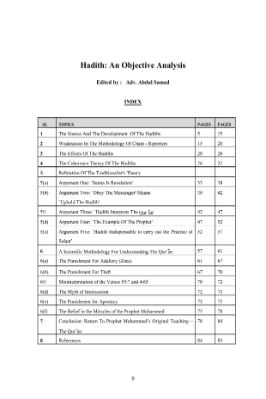
| Hadith: An Objective Analysis | |
| SAMAD | |
| 85 | |
| 0.53 Mb(s) | |
|
|
| English | |
| Click to Read the Book Online | |
| PDF Direct Download Link |
Hadith-_-An-Objective-Analysis.pdf
To read more about the Hadith An Objective Analysis Pdf bookClick the download button below to get it for free
Excerpts from the Book – Text format
The fourth criterion is overall agreement within Hadith as a whole. It means that any oneHadith should comply with similar Hadiths, which give the same sort of story, and that thisshould be seen as a basis for accepting it as authentic. In modern parlance, it means that thevarious stories should ‘hang together’, that one account should not in conflict with another,and if there is no conflict, we should assume that the story is, therefore, true.
The intelligentand attentive reader who takes his time to read a moderate number of even so-called sahihHadith on any subj ect will not need to go far before he finds a distinct failing on this count.Reflections on the Definition of ‘Sahaba’The students of Muslim history will be shocked to find different definitions given for theword ‘Sahaba’ (Companion) of the Prophet by the Hadith compilers so that they have a fittingreason for them to get all the Hadiths included in their book.
On studying these definitions,any sincere Muslim searching for the truth can sense the confusion overtaking Bukhari andothers. Here are their definitions:(l) The definition by Imam A1-Bukhari: Bukhari defined the Sahabi (single of Sahaba) as theone who was in the company of the Prophet Muhammad or just SEEN him.
Ibn Hanbal whoalso has a book of his own collecting more Hadiths than Bukhari accepted this definition andclarified it by adding “The Sahabi is anyone who accompanied the Prophet for a year, amonth, a day or even an hour or even just seen him. “(2) The definition by Abdullah Ibn Umar Ibn A1-Khattab “anyone who has seen the ProphetMuhammad even for one hour as long as he reached the puberty, and is a known Muslim whounderstood his religion and accepted it.
“(3) The definition of A1-Tabaey Saeed Ibn A1-Museeb; “Only those who accompanied theProphet Muhammad for a year or two and fought with him in a battle or two should beconsidered Sahaba” This is a definition accepted and encouraged by Imam A1-GhazaliBukhari’s definition that anyone who has seen the Prophet is a Sahabi has no support from theQur’an.
The Qur’an gives stories of the hypocrites and the wicked people of Medina, wherethe Prophet lived, who have seen the Prophet and listened to his message and his ceremonies.Undoubtedly, they cannot be considered his Sahaba (Companions), but Bukhari did viewthem such simply because they have seen the Prophet.
Therefore it is fundamentally wrong toplace our faith in or to take for granted the prevalent theory that each and everyone who livedcontemporaneously with the Prophet was an honest and trustworthy companion.(3) The Effects of the HadithOne of the most important aspects, neglected so far in any study on the Hadith, is theircollective impact and effects on Muslim society.
We have seen that the fabrication of Hadithtook place because of the politico-religious divisions that later resulted in the emergence ofsects and legal schools. The Hadith became the instrument to channel views, prejudices,customs and superstitions current in society then. Most of these views and ideas were nothingbut superstitions and customs rejected by Islam.The Qur’an tells us that God in His mercy has always sent His guidance to mankind throughHis messengers.
He guides mankind with His revelations to the path of salvation, in thisworld and in the Hereafter. These Prophet-messengers began with Adam in the remotePrimitive Age, through Abraham at the beginning of the Ancient Age to the last ProphetMuhammad at the dawn of the Scientific Age. Deviation from these divine revelations spellsdoom and destruction for the deviating society. The Qur’an tells us of the destruction of20

 Don't Miss out any Book Click Join OpenMaktaba Telegram group
Don't Miss out any Book Click Join OpenMaktaba Telegram group